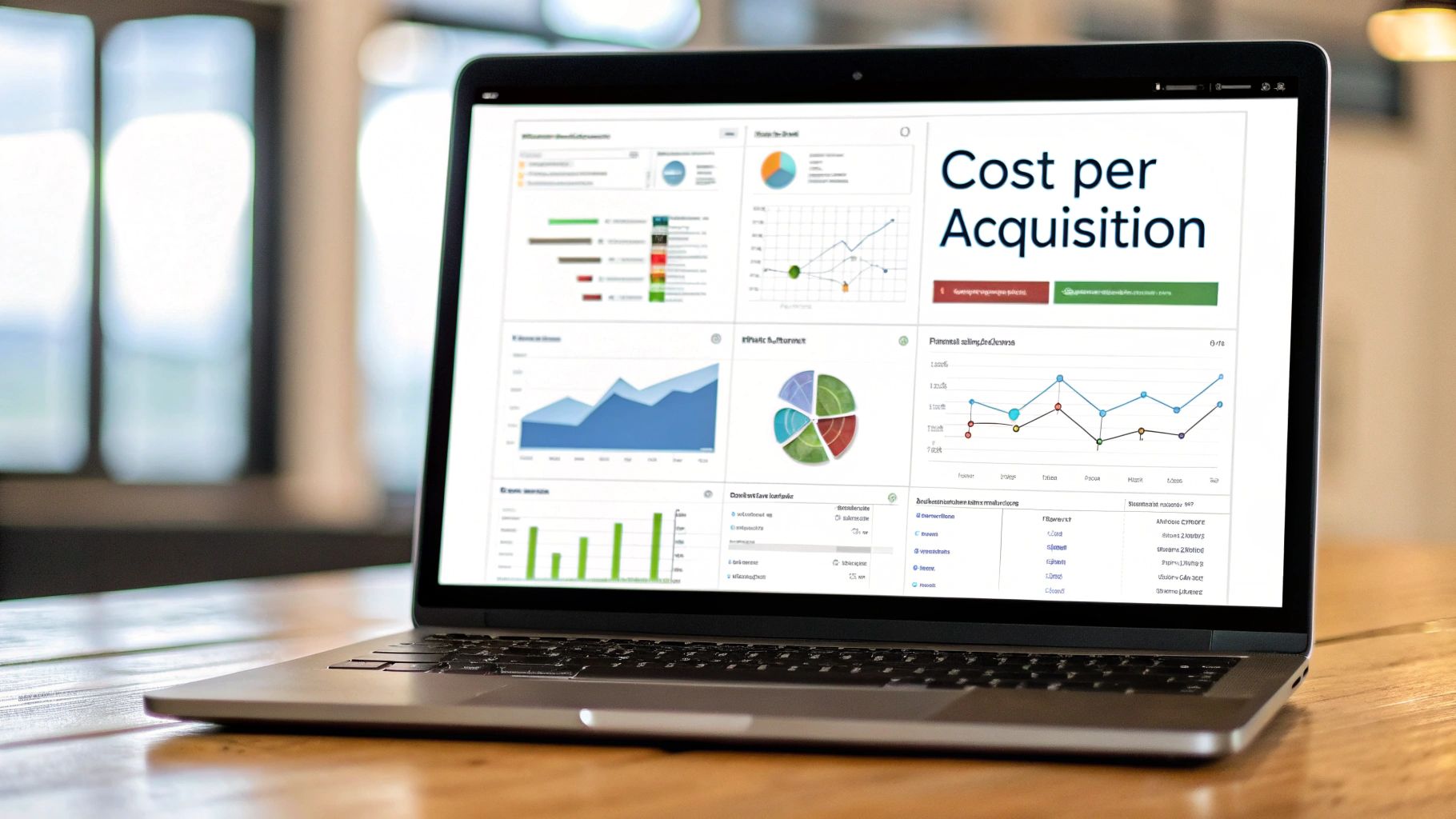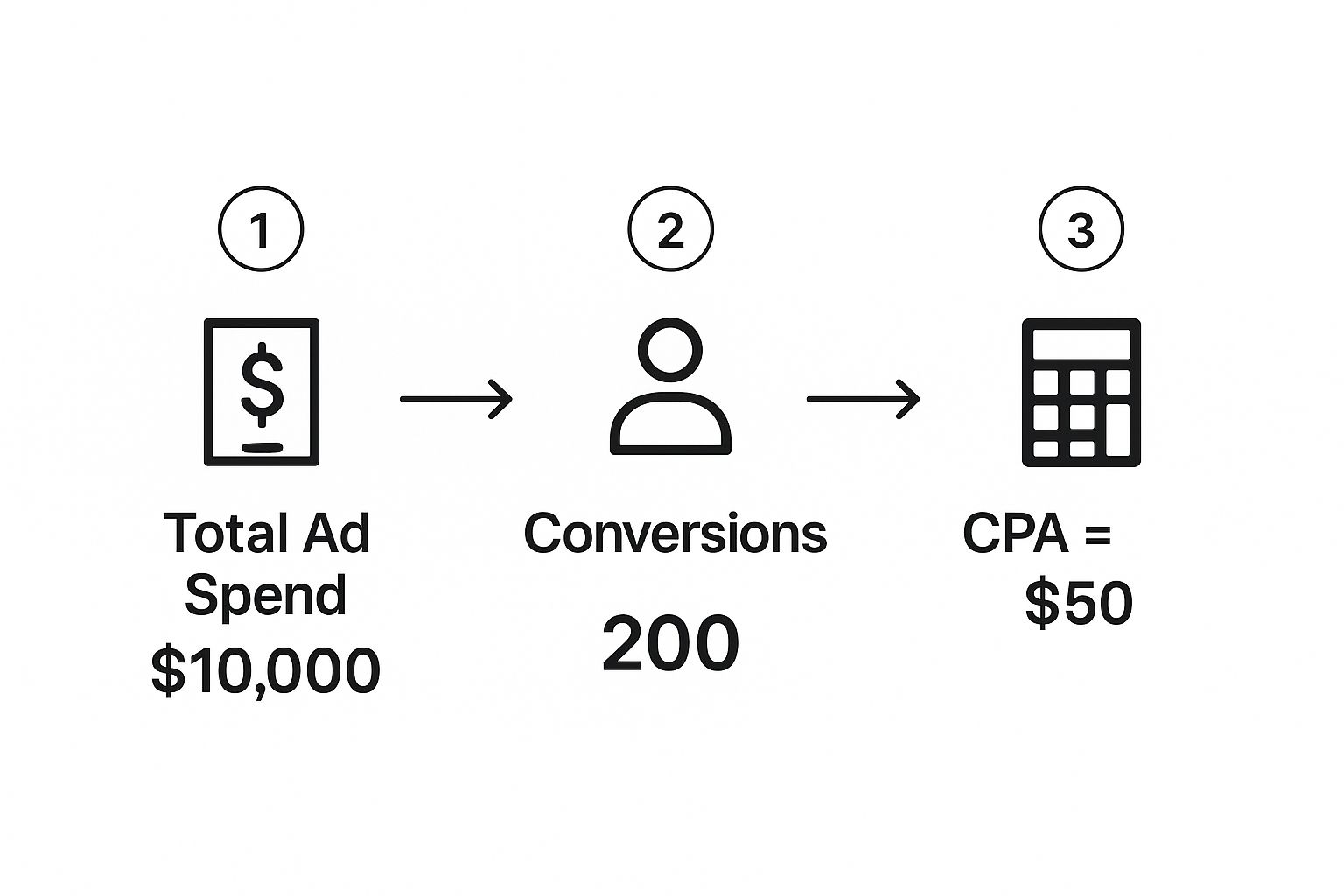August 27, 2025
What Is Cost Per Acquisition A Simple Guide


Ever heard the term Cost Per Acquisition, or CPA, and wondered what it really means? In a nutshell, it's the total cost you pay to get one new customer through a specific marketing effort.
Think of it as the price tag for winning over each new client. It's the bottom-line metric that tells you whether your ads are actually making you money or just burning a hole in your pocket.
Getting a Grip on Cost Per Acquisition

Let's ditch the marketing jargon for a second and use a real-world example.
Imagine you're running a small online store that sells handmade hats. You decide to run some ads on Instagram to attract new buyers, and you spend $100 over the course of a week. When you look at your sales data, you see that 10 new customers bought a hat after clicking on your ads.
So, what is the cost per acquisition here? It's simply your total ad spend divided by the number of new customers you got.
You spent $100 and got 10 customers, which means your CPA is $10 per customer. This single number is absolutely crucial for figuring out if your marketing is actually profitable.
So, What Actually Counts as an "Acquisition"?
Here’s where things get interesting. A common mistake is thinking an "acquisition" only means a sale. While it often does, the true definition is much more flexible and really depends on what you want to achieve with a specific ad campaign.
What you count as a successful acquisition can look very different from one business to another.
- E-commerce Store: The most straightforward one—a completed purchase.
- SaaS Company: This could be a free trial sign-up or a booked demo.
- Content Creator: A new subscriber to a paid newsletter is a perfect example.
- Local Plumber: It might be a filled-out contact form or a booked appointment.
Basically, an acquisition is whatever valuable action you want someone to take after they see your ad.
By clearly defining what an 'acquisition' means for each campaign, you can measure the true impact of your ad spend. It turns marketing from a guessing game into a predictable engine for growth.
To make these concepts even clearer, here’s a quick breakdown of the core ideas.
CPA Concepts at a Glance
This table sums up the key terms you'll encounter when dealing with Cost Per Acquisition.
Understanding these pieces helps you see how everything fits together to give you a clear picture of your campaign's performance.
Why CPA Is a Metric You Can't Ignore
Tracking your CPA is like giving your marketing campaigns a regular financial health check. It tells you, in no uncertain terms, what you're shelling out to bring each new person into your business's world.
Flying blind is never a good strategy. Without knowing your CPA, you're just throwing money at ads and hoping for the best.
When you understand this number, you can finally make smart, data-backed decisions. It shines a spotlight on the marketing channels that are your true performers and exposes the ones that are just draining your budget. By keeping a close eye on your CPA, you can fine-tune your entire strategy and make sure every dollar you spend is working as hard as it can to grow your business.
How to Calculate Your Cost Per Acquisition
Alright, let’s get down to the numbers. Figuring out your CPA isn't as scary as it sounds. In fact, the formula itself is surprisingly simple, but the insight it gives you is incredibly powerful.
At its heart, here’s all you need to know:
CPA = Total Marketing Cost ÷ Total Number of New Acquisitions
That’s it. This one calculation tells you exactly how much you’re shelling out, on average, to get a single customer to do the thing you want them to do. If you want a hand with the math, a customer acquisition cost calculator can do the heavy lifting for you.
Putting the CPA Formula into Action
Let's walk through a few real-world scenarios to see how this plays out. The trick is to be crystal clear on what you’re counting as an "acquisition."
Example 1: The E-commerce Brand
Imagine you run an online store and you just launched a new line of sneakers using Google Ads.
- Total Ad Spend: You put $5,000 into the campaign.
- Acquisitions: The ads drive 250 sales of the new sneakers.
- Calculation: $5,000 ÷ 250 sales = $20 CPA
Simple as that. For every $20 you spent on ads, you sold one pair of sneakers. Now you have a baseline.
Example 2: The SaaS Company
Now, let's switch gears to a software company. Their main goal isn't an immediate sale but getting people to sign up for a free trial.
- Total Ad Spend: They spend $10,000 on LinkedIn ads for the month.
- Acquisitions: This brings in 200 new free trial sign-ups.
- Calculation: $10,000 ÷ 200 sign-ups = $50 CPA
So, it costs them $50 to get one person to try their software. This number is crucial for them to weigh against the rate at which those trial users eventually become paying customers.
This visual really helps break down how ad spend flows directly into conversions, giving you that final CPA.

As you can see, a $10,000 spend that pulls in 200 conversions makes the math easy: that's a CPA of $50 per acquisition.
Example 3: The Local Plumber
Finally, what about a local service business? Let's say a plumber wants their ads to generate booked appointments directly from their website.
- Total Ad Spend: They run a local search campaign with a $1,500 budget.
- Acquisitions: The campaign results in 30 new, confirmed appointments.
- Calculation: $1,500 ÷ 30 appointments = $50 CPA
Each confirmed job cost them $50 in ad spend. This tells the plumber whether their marketing dollars are actually turning a profit when compared to the revenue from each job.
What Costs Should You Actually Include?
Here’s where a lot of people trip up. To get a true CPA, you need to think beyond just the ad spend. Your "Total Marketing Cost" should be a bit more comprehensive.
Think about including:
- Direct Ad Spend: This is the obvious one—the money you pay directly to Google, Meta, or LinkedIn.
- Creative Costs: Did you pay a designer for ad visuals? A copywriter? A video editor? That all counts.
- Software & Tools: The subscription fees for any analytics platforms, management tools, or marketing software you used.
- Salaries: A portion of the salaries for the marketing team members who are actually running the campaigns.
Tossing all of these associated costs into the pot gives you a much more honest look at your investment.
Just look at the mobile app industry for a perfect example of how wildly these costs can fluctuate. Back in 2018, the cost per install (CPI) on Instagram was around $2.75. Fast forward to 2021, after Apple’s iOS 14.5 privacy update shook things up, that number jumped to a whopping $15.00. It’s a stark reminder that external factors can completely change the game.
Why CPA Is Your Marketing North Star

Let's be honest, some marketing metrics are just vanity. They look nice in a report but don't really tell you much. Cost Per Acquisition is not one of them.
Think of CPA as the compass for your entire marketing strategy. It's the one number that keeps you pointed directly toward profitability. It cuts through the fluff and answers the most important question: are your ads making you money, or just burning through your budget?
Without a firm grip on your CPA, you're basically flying blind. But once you have it, you can start making smart, data-driven decisions that lead to real, sustainable growth.
A Clear View of Profitability
At its heart, CPA tells you whether you're in the black or in the red with your marketing. Every business knows, down to the dollar, what it can afford to spend to get a new customer. CPA is the metric that shows you if you're hitting that mark.
It’s pretty simple. If your product sells for $100 and your CPA is a lean $20, you're in a fantastic spot. But if that CPA creeps up to $110, you’ve got a serious leak in your financial boat. CPA ignores clicks and impressions to focus on the only thing that truly matters: the final cost of getting a paying customer.
This kind of clarity is a game-changer. It turns your marketing department from a "cost center" into a measurable engine for growth.
CPA is the bridge between what you do in marketing and what you earn as a business. It connects the dots from ad spend to actual revenue, giving you undeniable proof of your impact on the bottom line.
Strategic Budget Allocation
Once you start tracking CPA across different channels, allocating your budget becomes incredibly straightforward. Imagine you're running campaigns on both Google Ads and LinkedIn.
Let's say you discover:
- Google Ads CPA: $50
- LinkedIn Ads CPA: $150
That data instantly screams that every dollar you spend on Google is working three times harder. Does this mean you should kill the LinkedIn campaign? Not necessarily. But it's a massive flashing sign telling you to shift more of your budget to the channel that's delivering more efficient results.
This is how you stop guessing and start investing. You put more fuel into the engines that are running hot and figure out how to fix—or cut—the ones that are sputtering.
This kind of strategic thinking isn't just for marketing; it mirrors how smart businesses operate on a larger scale. For instance, global merger and acquisition (M&A) deal values have climbed, with the average deal hitting around $73 million in 2024. This shows how companies are carefully weighing the cost of an acquisition against its potential long-term value. As a marketer, you're doing the exact same thing—just with customers instead of companies. You can see more on how these economic trends impact big-picture investments with these M&A deal value insights from Statista.
Proving Your Marketing ROI
When it comes time to justify your budget, CPA is your best friend. It’s a simple, powerful number that anyone in the C-suite can understand immediately.
Instead of showing up with a confusing spreadsheet full of clicks, impressions, and click-through rates, you can walk in and say:
"Last month, we spent $10,000 and brought in 200 new customers. Our cost to acquire each one was $50."
That sentence is clear, confident, and ties your work directly to the health of the business. It proves your value, builds trust, and makes it a whole lot easier to get the resources you need to do even more. In short, mastering your CPA is how you become a hero in your organization's growth story.
What Is a Good Cost Per Acquisition Anyway?
So, what's the magic number? It’s the million-dollar question every marketer asks, but the honest answer is a bit of a letdown: it depends entirely on your business.
There's no universal "good" Cost Per Acquisition. A CPA that would be a massive win for one company could sink another. It all comes down to context. The real goal isn't to chase some arbitrary industry number but to figure out what a healthy CPA looks like for you.
This means the most important relationship in your marketing universe is the one between what you pay to get a customer and what that customer is worth to you over time.
The Critical Link Between CPA and LTV
The key to understanding what makes a good CPA is Customer Lifetime Value (LTV). LTV is simply the total amount of money you can realistically expect from a single customer throughout their entire relationship with your business.
Think of it like this: CPA is your upfront investment to get a customer in the door, and LTV is the total return you get from that investment. A "good" CPA is just one that's significantly lower than your LTV.
Let’s look at two completely different businesses to see this in action:
Scenario A: The High-End Software Company: This company sells a powerful analytics tool on an annual subscription. Their average customer sticks around for five years, paying $1,000 per year. That gives them an LTV of $5,000. If their CPA is $500, they're popping the champagne. They’re spending $500 to make $5,000—a fantastic 10x return.
Scenario B: The E-commerce T-Shirt Store: This store sells trendy t-shirts for $25 a pop. On average, a customer buys twice a year for two years. Their LTV is $100. If their CPA is $50, they’re in big trouble. Spending $50 to make $100 leaves practically no room for the cost of the shirt, overhead, and profit. That $50 CPA is a disaster.
As you can see, the exact same CPA figure can mean wildly different things. Your profit margins and customer loyalty are the ultimate judges.
A good CPA isn't a static number—it's a profitable ratio. As long as your CPA is comfortably below your LTV, your business has a sustainable engine for growth.
Setting a Target CPA You Can Actually Use
So, how do you set a realistic target? Start by calculating your LTV. Once you have that number, you can work backward to find a CPA that keeps you profitable.
A common rule of thumb is the 3:1 LTV to CPA ratio. This means your customer's lifetime value should be at least three times what you paid to acquire them. This 3:1 cushion gives you enough breathing room to cover all your other business costs—like salaries, software, and the cost of the products themselves—while still leaving a healthy profit.
Of course, this isn't set in stone. A startup might be willing to accept a tighter 2:1 ratio just to grab market share, while a well-established brand might shoot for 4:1 or even higher.
To make sure you're measuring this all correctly, having a rock-solid tracking system is non-negotiable. You can learn more about setting this up in our guide to Google Ads conversion tracking.
How Do You Stack Up Against Industry Benchmarks?
While your own LTV is your north star, it doesn't hurt to peek at industry benchmarks to get a general sense of where you stand. Customer Acquisition Cost (CAC), which is functionally the same as CPA, varies dramatically from one industry to another.
In 2024, B2B industries saw a massive range, from $187 in pharmaceuticals to an eye-watering $1,450 in fintech. The average for specialized IT services is around $454, while legal services clock in at $749, likely due to longer sales cycles. This huge variation shows how things like product complexity and sales strategy directly impact acquisition costs. You can explore more industry-specific acquisition cost data to see how different fields compare.
Ultimately, these numbers are just a starting point. Use them for context, but always bring the focus back to your own business model. A good CPA is one that fuels your growth profitably.
Actionable Strategies to Lower Your CPA

Alright, so you know what Cost Per Acquisition is and why it matters. Now for the fun part—actually getting that number down. Lowering your CPA isn't about gutting your budget; it’s about making every single dollar you spend work smarter and harder for you.
There’s no magic bullet here. Instead, it’s all about making continuous, smart tweaks across your entire campaign. From the ad someone sees to the landing page they click through to, there are opportunities to tighten things up everywhere.
Let's get into the practical, hands-on tactics you can use to get more customers for less cash.
Fine-Tune Your Audience Targeting
One of the quickest ways to light your ad budget on fire is showing ads to the wrong people. Every wasted impression and irrelevant click makes your CPA climb higher. The fix? Get laser-focused on exactly who you're trying to reach.
Start by digging into your own customer data. Who are your absolute best customers? What do you know about their demographics, their interests, their online habits? Use that intel to build sharp audience profiles and target them directly.
And don't forget about the power of negative keywords. It's wild, but some studies show that a staggering 75% of search campaigns waste money because of bad keyword targeting, usually from terms that are just too broad. Make it a habit to check your search term reports and add any junk queries to your negative keyword list. This one move stops you from paying for clicks that were never going to convert anyway.
Enhance Your Ad Creative and Copy
Your ad is your first handshake. If it doesn't connect, you're just paying for clicks that lead nowhere. The goal is to create ads that not only grab attention but also pre-qualify your audience, so only the folks who are genuinely interested actually click.
Here’s how to make your ads sharper:
- Speak Directly to Pain Points: Don't just list features. Talk about the specific problem your audience is trying to solve. Show them you get it.
- Use Strong Calls-to-Action (CTAs): Be crystal clear about what you want them to do. "Get Your Free Quote" is worlds better than a fuzzy "Learn More."
- A/B Test Everything: Stop guessing what works. Constantly test different headlines, descriptions, images, and CTAs to see what combination gets you the lowest CPA. Even tiny tweaks can make a huge difference.
An optimized ad acts like a filter, attracting high-intent users while discouraging casual browsers. This simple shift can dramatically improve conversion rates and slash your acquisition costs.
By creating compelling, relevant ads, you not only get better clicks but also boost your Quality Score on platforms like Google Ads. A higher Quality Score gets you a discount on ad costs, which directly lowers your CPA. For more on this, check out these 10 search engine marketing best practices for 2025.
Optimize Your Landing Page Experience
Getting the click is only half the battle. If your landing page is clunky, confusing, or just doesn't deliver on the ad's promise, all that ad spend goes right down the drain. A high-converting landing page is probably the most powerful weapon you have for lowering your CPA.
Think of it as the final handshake that closes the deal. It has to be on point.
Here’s a simple checklist to run through:
- Message Match: The headline and vibe of your landing page must perfectly match the promise you made in your ad. If there's a disconnect, people will bounce immediately.
- Clear and Simple Design: Avoid clutter like the plague. Use a clean layout, plenty of white space, and a single, obvious call-to-action that’s impossible to miss.
- Build Trust: Add in social proof. Customer testimonials, reviews, or case studies go a long way in making people feel comfortable converting.
- Mobile-First Optimization: Most of your traffic is coming from phones. Test your page on different devices to make sure it’s fast, responsive, and easy to use on a small screen.
Improving these elements turns more of your clicks into customers without you spending a dime more on ads. The result? A naturally lower CPA. It’s also worth exploring different payout models; some platforms like Costaction offer frameworks that tie costs to specific actions, helping you keep a tight grip on your CPA.
Your CPA Optimization Checklist
To pull this all together, here’s a quick checklist you can use to audit your own campaigns. Think of it as a go-to guide for spotting opportunities to bring that CPA down.
Working through these areas systematically is the surest way to make progress. It's not about one big change, but a series of small, smart improvements that add up over time.
Putting It All Together: Your CPA Action Plan
Alright, let's land this plane. We've walked through what Cost Per Acquisition is, how to crunch the numbers, and why it’s arguably the most vital sign of your marketing's health. Now for the fun part: putting that knowledge into action.
The goal here isn't complicated. It's about getting you to stop guessing and start making decisions based on real data. Think of this less as a one-off task and more as a rhythm you build into your marketing—a continuous cycle of testing, learning, and tweaking.
When you make CPA a core part of your process, your campaigns stop being just an expense line. They become a predictable, profitable engine that actually grows your business.
From First Steps to Full Control
We’ve covered the entire journey, from figuring out the basics to making confident, data-backed calls. It all boils down to a few key moves you're now ready to make.
Here's the game plan, simplified:
- Nail Down Your "Acquisition": First things first, get super clear on what counts as a win. Is it a completed sale? A free trial signup? Someone booking a demo? This one definition is the cornerstone of your entire CPA strategy.
- Do the Math: Next, grab that simple formula—Total Cost ÷ Total Acquisitions—and figure out your baseline CPA. Just remember to toss all the relevant costs in there to get a true number.
- Get Some Perspective: How does your CPA stack up against your Customer Lifetime Value (LTV)? A healthy 3:1 ratio is a great benchmark. A good CPA isn't just a low number; it's a number that lets you grow your business without going broke.
- Never Stop Optimizing: Finally, roll up your sleeves and start optimizing. This is where you constantly refine your audience targeting, punch up your ad copy and creative, and smooth out your landing pages to nudge that CPA down.
The Never-Ending Improvement Loop
Managing your CPA isn't a project with a finish line. It's a loop. It’s a cycle that should become second nature for you and your team.
If you remember one thing, make it this: Mastering your Cost Per Acquisition is a process, not a destination. Every campaign gives you new data, fresh insights, and another chance to get a little bit smarter with your budget.
This constant cycle forces you to adapt and stay sharp. Are my ads still hitting the mark? Is my landing page turning visitors into customers? Is my targeting still on point? Asking these questions over and over again, with CPA as your north star, is how you win.
You've got the framework and the know-how. You get the "what" and the "why." Now it's your turn to go build a smarter, more profitable marketing machine, one measured step at a time. The real magic happens when you make those small, consistent improvements that stack up into huge results down the road.
Ready to stop wasting ad spend and start optimizing like a pro? keywordme gives you the tools to clean up junk search terms, find high-converting keywords, and slash your CPA, all from one intuitive platform. Start making every dollar count by signing up for your free trial at https://www.keywordme.io.


.svg)